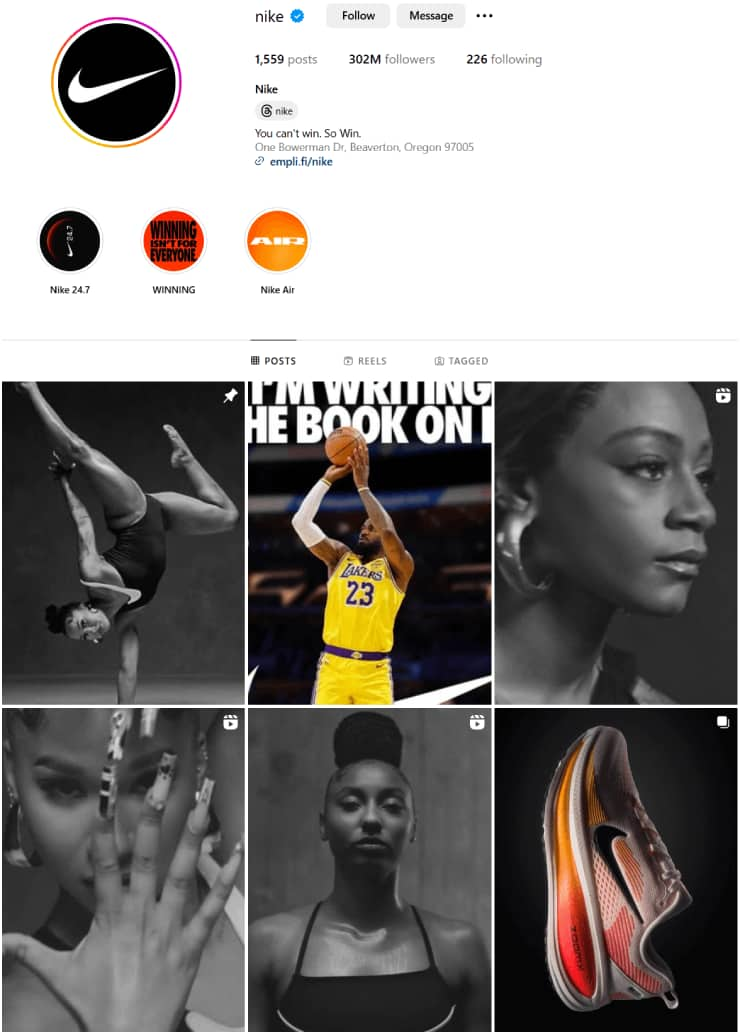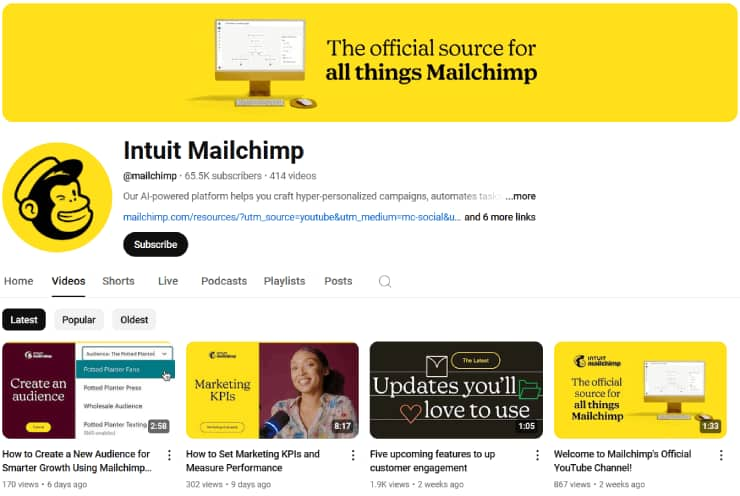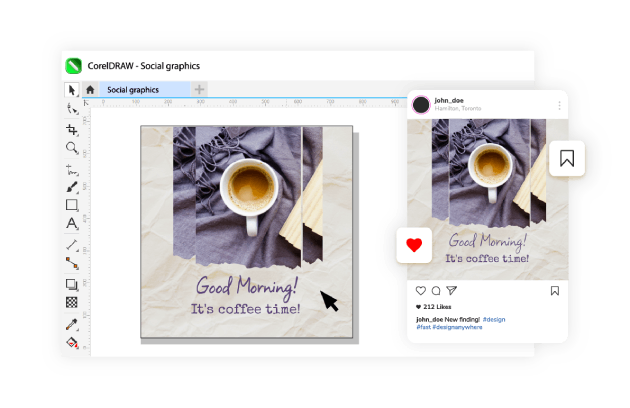Social media is undeniably a big part of our lives these days. But even though more of your audience is present on these platforms, you might find it’s harder to reach them.
Between shorter attention spans and increasing numbers of posts (organic and otherwise!), it takes more for brands to reach their consumers.
In a psychological study beginning in 2004 and lasting approximately 15 years, the human attention span decreased from 2.5 minutes to a median of 40 seconds or less. And that was before we had TikTok!
Q: With that in mind, what can you do to draw your target audience’s eyes to your posts?
A: Design social media graphics that tell them everything they need to know at a glance.
Looking for a way to get started with social media graphic design quickly? Sign up for a free trial of CorelDRAW Go today!
Why do social media graphics matter?
They say a picture’s worth a thousand words, but it’s not just a saying—it’s science. Our minds process images thousands of times faster than words.
When those images we see have consistent elements, they build familiarity in our brains.
This leads to something called the mere exposure effect, a psychological phenomenon in which the familiarity we feel with a source becomes trust in it.
In other words, if we see things often enough, we trust them. And people tend to buy from brands they trust.
The bottom line: Creating your own graphics for social media helps you get through to people faster, build brand trust, and attract business.
How to design social media graphics: A step-by-step guide
Before you start, you’ll want to consider your goals for the post, your target audience’s interests, and the platform you’re posting on.
And once you start designing, you’ll want to consider formatting, brand elements, and the overall quality of your graphic.
1. Set your goal
Social media graphics can serve several purposes. Are you posting them on your feed? Are they going on your profile as part of your brand? What you need to accomplish will define how you need to design.
2. Determine what resonates with your audience
People go on social media for different reasons.
Where a Millennial might look for entertainment, a Gen Z-er may look for brand information.
Knowing what your audience wants from you will help you find the right message to give them, which will boost engagement on your post.
3. Choose the right platform for your content type
Each platform calls for a different type of content.
LinkedIn readers may expect a well-written and illustrated article, but Instagram users want to see visual-first posts.
Deciding where your graphic is going will help you decide on its format.
4. Start your graphic with a template or from scratch
Whether you want to start with a blank slate or need a jump-start for your inspiration, your design software should be able to help. Just be sure to pick the right image size for your target platform!
5. Choose high-quality images and graphic elements
Starting your design with quality images will keep it looking sharp and appealing.
You can also use vector-based graphic elements to help you keep your design’s quality at any image size.
Heads up: If your social media post maker doesn’t include elements you can use, look for image and vector sites that provide CC0 assets. This Creative Commons license gives you full freedom to use those assets, even for commercial use!
6. Incorporate your brand elements
Does your brand have established colors? Designs? Fonts?
Using these in your social media posts will tie them together visually and build brand recognition on your profiles.
7. Be mindful of your text and backgrounds
Keep any text on your social media designs short, clear, and easy to see. Make sure you pick fonts and colors that will contrast against your background.
8. Use a clear call-to-action
You won’t always need a call-to-action on your graphics, but if you do, make sure readers can’t miss it.
Use clear, easy-to-see colors and fonts—you can even try using buttons and shapes to draw your readers’ eyes.
9. Test your design
Screens are not one size—or one color scheme—fits all.
Test your design on different screens to make sure fonts stay readable, and color elements don’t fade together.
How to choose the right image size for your graphic
Social media platforms are coded to fit certain dimensions for graphics and videos. You’ll want to keep these in mind when creating your graphic to make sure it doesn’t get cropped, compressed, or warped unexpectedly.
| X / Twitter | YouTube | |||||
|---|---|---|---|---|---|---|
| Brand | Profile picture | 110 x 110 px | 400 x 400 px | 180 x 180 px | 200 x 200 px | 800 x 800 px |
| Cover picture | 1500 x 500 px | 820 x 312 px | 1584 x 396 px | 2560 x 1440 px | ||
| Content | Landscape | 1080 x 566 px | 1024 x 512 px | 1200 x 630 px | 1104 x 736 px | 1920 x 1080 px |
| Portrait | 1080 x 1350 px | 512 x 1024 px | 630 x 1200 px | 736 x 1104 px | ||
| Square | 1080 x 1080 px | 1024 x 1024 px | 1200 x 1200 px | 1104 x 1104 px | ||
| Story | 1080 x 1920 px | 1080 x 1920 px | 1080 x 1920 px |
Famously the platform for square images, Instagram uses square images that measure 1080 x 1080 px with an aspect ratio of 1:1.
It also supports portrait images that measure 1080 x 1350 px with an aspect ratio of 4:5 and landscape images that measure 1080 x 566 px with an aspect ratio of 1.91:1.
It’s worth noting that landscape images tend to shrink in Instagram’s style of feed. Some users get around this by splitting landscape images into multiple square images and posting them as a carousel.
X / Twitter
X or Twitter uses landscape images that measure 1024 x 512 px with an aspect ratio of 2:1.
It also supports portrait images that measure 512 x 1024 px with an aspect ratio of 1:2 and square images that measure 1024 x 1024 px with an aspect ratio of 1:1.
The least forgiving of the social media platforms, Facebook uses landscape images that measure 1200 x 630 px with an aspect ratio of 1.91:1.
It also supports portrait images that measure 630 x 1200 px with an aspect ratio of 1:1.91 and square images that measure 1200 x 1200 px with an aspect ratio of 1:1.
It’s worth noting that by default, Facebook will automatically crop large images—it won’t shrink or warp them.
LinkedIn uses landscape images that measure 1104 x 736 px with an aspect ratio of 3:2.
It also supports portrait images that measure 736 x 1104 px with an aspect ratio of 2:3 and square images that measure 1104 x 1104 px with an aspect ratio of 1:1.
5 social media design tips and examples from brands
With the essentials covered, let’s talk about the small details that make a big difference.
From eye-catching focal points to clever text placement, these tricks will help your content stand out—just like the brands that do it best.
1. Use focal points to draw attention
Giving your viewers a specific focal point means they’ll absorb your message faster. You’ll often see this done with essential design tactics like the rule of thirds and negative space.
Nike is a brand that does this well. Its feed is full of high-contrast images designed to focus the eye away from empty space and in on the post’s subject matter.

2. Use text strategically
When you add text to images, remember to keep it light.
Fewer words (especially ones in bold fonts) will give your text space to exist without being cluttered by your graphics, and help readers skim your post better.
Mailchimp does this well with its YouTube channel. Bold text with just a few key words gets each video’s message across clearly.

3. Use essential best practices
Basic design concepts like color theory can make a big difference for your posts.
Details like your brand colors have meaning, and those meanings can make a difference in your designs.
For example, while greens and blues are typically considered peaceful and calming colors, reds and oranges often communicate energy and urgency.
Owlet is a brand that does this well, working with soft pastel shades to invoke the calm feeling it wants its audience to reach.

It’s also worth considering techniques like visual hierarchy.
People will naturally see more prominent elements in your designs first.
Understanding that psychology can help you place the most important messages front and center.
4. Make consistency your superpower
Even as you’re experimenting with different aspects of your designs, remember to keep some elements consistent (note I didn’t say identical!). This will help build the familiarity we talked about earlier.
Later is a brand that does this well. It uses a fresh palette and iconic design elements—consistent across its website and social media platforms—to create instantly recognizable content.
As a bonus, you can see that intentionally breaking this pattern also has an impact, making big announcements stand out from the feed.

5. Adapt your design for different platforms
If your graphic needs to go on multiple platforms, you’ll need to make sure it looks good on each one. Be sure to resize and adjust your design!
Pro tip: Did you know CorelDRAW Go comes with lots of handy features specifically designed to help you adapt one design into multiple sizes? Get your free trial and see how it works today!
Create social media graphics that grab attention and stop the scroll
You’ve got the basics under your belt. You know the tips and tricks that will help you stand out. You’re ready to draw in your target audience’s attention, even with shorter attention spans and more noise to break through.
Now’s the time to make it all happen, and your free trial of CorelDRAW Go—our new design software made to make your social graphics simple—is here to help. Start your trial today !


